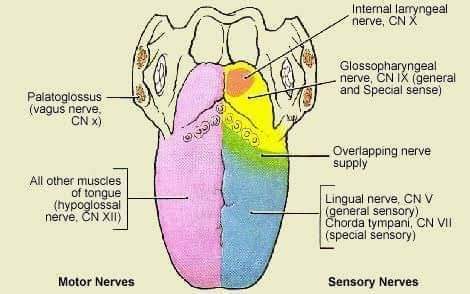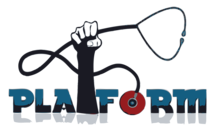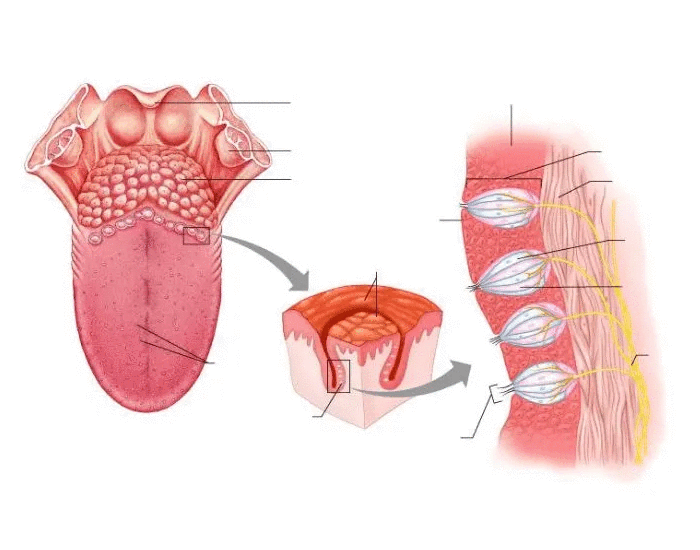𝐓𝐎𝐍𝐆𝐔𝐄:
⭕Muscular organ in the oral cavity.
🔰𝑭𝑼𝑵𝑪𝑻𝑰𝑶𝑵:
1) Organ of taste.
2) Helps in –
a) Speech,
b)Mastication,
c)Deglutition
🔰𝑬𝑿𝑻𝑬𝑹𝑵𝑨𝑳 𝑭𝑬𝑨𝑻𝑼𝑹𝑬𝑺:
- Root: Attached to the mandible and Hyoid bone by muscle.
- Tip: Anterior free end, comes into contact with the central incisors.
- Body: Body has –
2 surfaces: Dorsal & Ventral surface
2 lateral borders: Right & Left borders
⭕𝐃𝐨𝐫𝐬𝐚𝐥 𝐬𝐮𝐫𝐟𝐚𝐜𝐞 :
Divided by V shaped sulcus Terminalis into 2 parts-
1) Anterior 2/3rd or Oral Part.
2) Posterior 1/3rd or Pharyngeal Part.
✨Features of Oral Part:
- A median furrow (represent the bilateral origin of tongue)
- Large number of Papillae/ Lingual papillae

💠 Papillae of Tongue:
a.Vallate Papillae- arranged in a V shaped row infront of Sulcus Terminalis.
b.Foliate Papillae- near the margin infront of Sulcus Terminalis.
c.Filiform Papillae- present in dorsum of tongue.
d.Fungiforn Papillae- present in apex and margin of the tongue.
◼️Features of Pharyngeal Part:
1.Large number of lymphoid follicle (lingual tonsil)
2.Large number of mucus & serous gland.
⭕ 𝐕𝐞𝐧𝐭𝐫𝐚𝐥 S𝐮𝐫𝐟𝐚𝐜𝐞:
Features of ventral surface:-
1.Frenulum Linguae- Median fold of Mucus Membrane.
2.Deep Lingual Vein- Seen on either side of Frenulum Linguae.
3.Plica Fimbriata- Lateral to the Lingual Vein.
✪ 𝑴𝑼𝑺𝑪𝑳𝑬𝑺 𝑶𝑭 𝑻𝑶𝑵𝑮𝑼𝑬:
➡️ 𝐈𝐧𝐭𝐫𝐢𝐧𝐬𝐢𝐜 𝐦𝐮𝐬𝐜𝐥𝐞:
1.Superior longitudinal
2.Inferior longitudinal
3.Transverse
4.Vertical
▪️Function: Alter the shape of the tongue.

➡️ 𝐄𝐱𝐭𝐫𝐢𝐧𝐬𝐢𝐜 𝐦𝐮𝐬𝐜𝐥𝐞:
1.Genioglossus (Safety muscle of tongue )
2.Hyoglossus
3.Styloglossus
4.Palatoglossus
▪️Function: Alter the movement of the tongue.
🔰 𝑨𝑹𝑻𝑬𝑹𝑰𝑨𝑳 𝑺𝑼𝑷𝑷𝑳𝒀 𝑶𝑭 𝑻𝑶𝑵𝑮𝑼𝑬:
▫️Lingual artery- Branch of External Carotid Artery.
▫️Ascending Pharyngeal artery- Branch of External Carotid Artery.
▫️Tonsillar artery- Branch of Facial Artery.
🔰 𝑳𝒀𝑴𝑷𝑯𝑨𝑻𝑰𝑪 𝑫𝑹𝑨𝑰𝑵𝑨𝑮𝑬 𝑶𝑭 𝑻𝑶𝑵𝑮𝑼𝑬:
▫️Apical group:
➡️ submental lymph node
▫️Marginal group:
➡️ submandibular lymph node
▫️Central group:
➡️ deep cervical lymph node
▫️Basal group:
➡️ jugulo digastric lymph node
◽All of the above drains into
➡️ Jugulo omohyoid lymph node.
🔰 𝑵𝑬𝑹𝑽𝑬 𝑺𝑼𝑷𝑷𝑳𝒀:
(With developmental background)
💠 Motor Supply:
🔹All the muscle supplied by- Hypoglossal nerve (except Palatoglossus,which is supplied by Cranial root of accesory via Pharyngeal plexus)

💠 Sensory Supply:
✨Anterior 2/3 rd –
🔹Develops from 1st pharyngeal arch,
🔹Supplied by:
1) Lingual nerve (General sensation)
2) Chorda tympani nerve (Special sensation)
✨Posterior 1/3rd-
🔹Develops from 3rd pharyngeal arch,
🔹Supplied by: Glossopharyngeal nerve.
✨ Posteriormost part:
🔹 Develops from 4th pharyngeal arch,
🔹Supplied by: Internal laryngeal nerve.
🔰 𝑳𝑰𝑵𝑰𝑵𝑮 𝑬𝑷𝑰𝑻𝑯𝑬𝑳𝑰𝑼𝑴 𝑶𝑭 𝑻𝑶𝑵𝑮𝑼𝑬:
💠 Non-keratinized Stratified Squamous Epithelium.
Tanzina Shahrin Faiza/ Central Medical College
Session: 2018 – 19
Platform Academia/ Sadia Afrin Ivy

